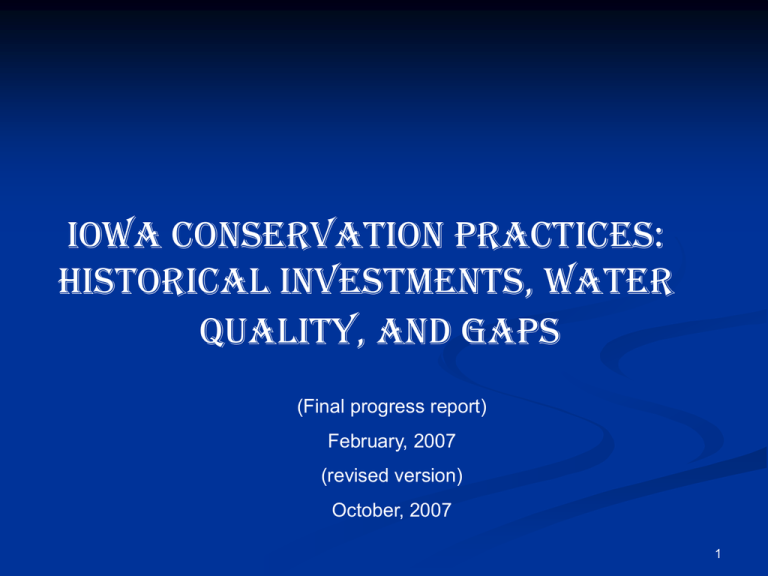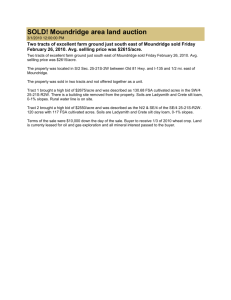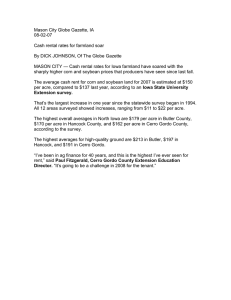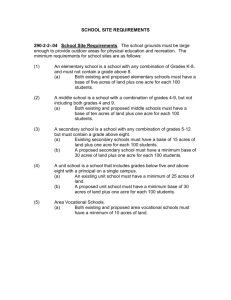Iowa Conservation Practices: Historical Investments, Water Quality, and Gaps (Final progress report)
advertisement

Iowa Conservation Practices: Historical Investments, Water Quality, and Gaps (Final progress report) February, 2007 (revised version) October, 2007 1 Project Overview Goals 1. What conservation practices are currently in place in Iowa, what is their coverage, and what is the cost of these practices? 2. What are (and have been) the effects of this investment on water quality? 3. What would it take to improve water quality to obtain specific standards? 3 Surveys Used NRI CTIC Description USDA Survey Reported findings from the USDA’s Crop Residue Management Survey Coverage Contour Farming Contour Stripcropping Filter Strips Grassed Waterways Terraces Erodibility Measures CRP Tillage Practices Years 1997 2004 Nature of Survey statistically based survey. Data were collected using a variety of imagery, field office records, historical records and data, ancillary materials, and a limited number of onsite visits “best estimates” of district conservationist are combined with Cropland Transect Surveys Positives 1. Records the total coverage of the practices (both those that received financial assistance and those that were installed voluntarily without funding). 1. Records the total coverage of the practices (both those that received financial assistance and those that were installed voluntarily without funding). Negatives 1. Conservation practice usage is calculated from a sample and so assumptions are made about the population. 1. Aggregate data (at the county level) that cannot be directly used in water quality modeling. 5 Statewide average cost Practice Statewide Average Cost Grass Waterway $2,127/acre Terrace $3.57/ft Water & Sediment Control Basin $3,989/structure Grade Stabilization Structure $15,018/structure Filter Strip $116.83/acre Contour Buffer Strip $78/acre Riparian Forest Buffer $486/acre Wetland Restoration $245/acre Nutrient Management $4.09/acre Contour Farming $6/acre No Till $17.94/acre Continuous CRP $142/acre General CRP $97/acre 6 Statewide Coverage Practice Statewide Coverage Grass Waterway (NRI) 2,225,900 acres Terrace (NRI) 1,997,900 acres Contour Stripcropping (NRI) 236,800 acres Contour Farming (NRI) 5,148,200 acres Mulch Till (CTIC) 8,290,000 acres No Till (CTIC) 5,220,000 acres CRP (CRP program) 1,894,488.2 acres 7 Total Costs of the Practices Practice Terraces Cost $692,147,676 Grassed Waterways $95,090,424 Contour Farming $30,889,200 Contour Stripcropping No-Till Much Till CRP $37,194,949 $3,552,000 $104,308,740 $82,861,900 $397,490,205 $175,878,365 The first two practices are structural practices. Divide the installation costs over the lifespan of the practices (terrace: 25yrs, GW: 10 yrs), then the sum of annual payment is: $37,194,949. The cost numbers for the rest of the practices are annual payments. Then the total annual costs would be: $37.2million + $397.5million = $434.7 8 13 Iowa Watersheds 10 % Improvement due to Existing Practices Flow Nitrate Org N Min P Org P Total N Total P Boyer -8 23 56 45 50 38 48 Des Moines -8 14 39 29 37 15 33 Floyd -4 19 42 41 44 25 42 Iowa -5 10 41 0 40 13 25 Little Sioux -7 20 52 40 50 24 47 Maquoketa -1 8 42 37 42 17 39 Monona -3 15 49 54 61 26 58 Nishnabotna -3 21 52 45 47 33 46 Nodaway -2 28 56 49 51 37 50 Skunk -6 14 46 40 44 21 42 Turkey -5 5 38 30 37 18 34 Upper Iowa -3 7 48 38 47 18 45 Wapsipinicon -8 6 46 34 45 11 40 11 What would it take to improve water quality? Numerous conservation practices could be implemented on any field, each with different levels of effectiveness and costs Solving for the least-cost solution requires comparison among a very large number of possible land use scenarios 13 Approach Evolutionary algorithms provide one search strategy mimic the power of evolution, which, in effect, is a method of searching for solutions among an enormous amount of possibilities (Mitchell, 1999) Outline basic idea only 15 Pareto Optimality Point A is not clearly preferred to point B (since B has lower costs, but higher pollution) Point C ought to be preferred to point D (since D exhibits both lower costs and lower pollution levels) We try to identify a frontier like ABC and then push it toward the origin 16 Flow diagram 18 Land use options considered 1. Land Retirement 2. Corn-Soybeans, Conventional Tillage 3. Corn-Soybeans, No-Till 4. Corn-Soybeans, 20% Fertilizer Reduction 5. Contouring 6. Terracing 7. Combinations (as sensible) of above practices 20 State-wide results Apply the evolutionary algorithm to the 13 watersheds A challenging task, given the number of HRUs and current computing capacity Results presented are based on over 91 days of CPU time Over 116,000 SWAT model runs Overall, the algorithm is able to identify scenarios which result in significant reductions in loadings of nitrates and phosphorus relative to baseline Results must be interpreted with caution: it is possible that better solutions could be identified, given enough CPU time 23 State-wide results: P-N targeting Watershed Boyer P loading, kg Actual P loading, % of baseline P concentration, mg/L Gross Cost, $ Net cost, $ N loadings, in % of baseline N concentration, mg/L 648,398 59.7 0.742 14,950,585 4,708,885 66.2 2.232 1,482,270 58.387 0.129 190,010,000 145,910,600 75.9048 4.514 295,676 52.2 0.560 8,056,582 2,778,832 64.2 4.494 2,432,160 67.1 0.206 193,575,632 109,999,532 75.2 6.189 Little Sioux 800,924 57.5 0.491 33,142,350 11,949,650 64.2 3.617 Maquoketa 14,589 39.8 0.323 2,218,699 -15,780,401 60.6 3.682 200,116 60.3 0.546 7,753,342 -1,491,738 55.1 4.158 2,068,920 67.3 0.625 43,579,662 13,676,562 65.1 2.408 354,088 61.6 0.401 8,140,247 3,370,077 72.9 2.049 1,842,720 63.6 0.482 50,379,561 29,196,661 75.2 2.595 Turkey 981,900 71.3 0.381 17,057,490 1,707,090 74 2.999 Upper Iowa 130,640 60.5 0.100 11,038,459 3,740,489 75.8 1.635 Wapsipinicon 413,100 67.6 0.135 33,030,359 12,112,059 70 3.861 Des Moines Floyd Iowa Monona Nishnabotna Nodaway Skunk 30 State-wide summary of P-N targeting The total gross cost of implementing the management scenarios is almost $613 million a year The net cost is estimated to run just under $322 million a year Following the prescriptions of the algorithm for each of the watersheds results in the state-wide reduction in phosphorus loadings of over 36% would simultaneously result in the state-wide reduction in nitrate loadings of over 31% 31 Comparison of selected watersheds: Des Moines 33 Nodaway 34 Scenario Maps 38 Distributions of options (alleles) and practices 700 600 500 400 300 200 100 0 T C S C S C C S N T R F Ar Te ea rra C T ce Te d A rra re c a ed C S R N F T Ar C Te S ea rra N T ce Te d A rra re ce a C d S R C F T Ar C C ea S on C to T u C rA on re to a ur C S R F N T A C re C S on a N t T ou C r on Ar ea to ur R F A re a Ar ea T N C S R F T C C S C S Ar e Ar ea T C P C R a Focus on N Focus on P and N Ar ea Sq. km Nodaway Watershed distribution of options Nodaway Watershed distribution by practice 1200 1000 Sq. km 800 Focus on N 600 Focus on P, achieve both N and P Baseline 400 200 0 CRP CS CT N reduction No Till Terrace Contouring 40 Conclusions and Recommendations Significant reductions in both phosphorus and nitrogen loadings can be achieved in all of the watersheds in the state The costs are significant But, much smaller than they would be if didn’t carefully select which practices go where (targeting) Focus on N alone produces a markedly different watershed configuration than when the focus is both on P and N Practices which are efficient for phosphorus and erosion control are, in general, not efficient in controlling nitrogen If we wish to focus to both nutrients, combining traditional structural practice with measures directly targeting nitrogen will be necessary 41 Caveats and Research Needs Inclusion of other options will very likely alter results Results needed to be interpreted with caution E.g., we do not recommend actual removal of conservation practices or abandonment of conservation tillage Lack of detailed spatial data only allows identification of desired conservation option mix at the subbasin level Better hydrologic, water quality, land use, and farm-level data would help to add realism to the analysis Studying sensitivity of the results to changes in costs, efficiencies of conservation practices and weather 42 conditions would be very helpful in providing Continuing Work Sergey Rabotyagov’s PhD thesis, Iowa updates UMRB work (also Sergey) Smaller watershed work (field scale) 2007 land and corn prices Added grassed waterways as an option Continued improvements to SWAT 30% N and P reductions ~ $300 million/yr cost Walnut Creek (CEAP project – USDA) Boone (USDA-CSREES) Application of GA for biofuels sustainability 43



